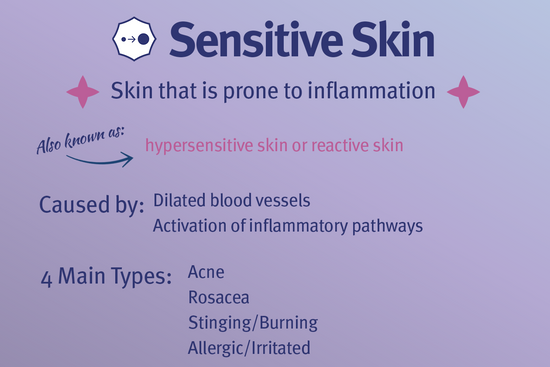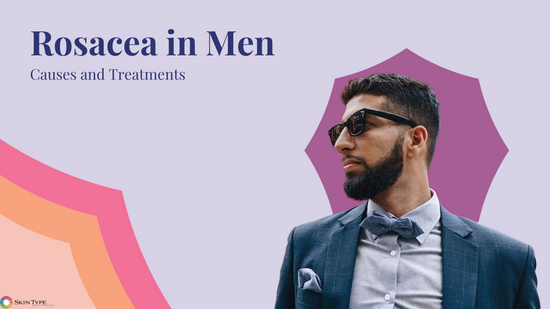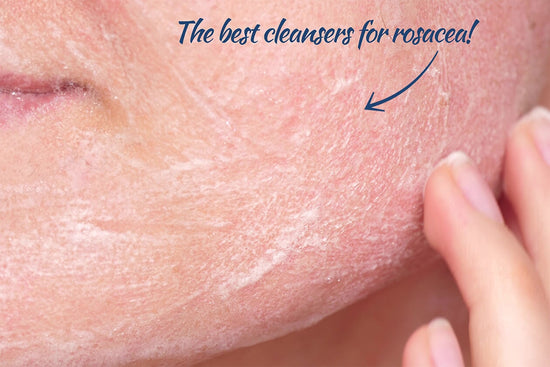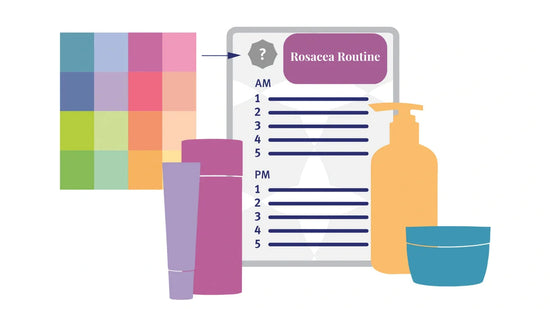Rosacea
Rosacea is a type of sensitive skin characterized by a pink or red face that flushes, itches, and burns. If you have facial flushing, stinging skin, or you notice that your face feels hot often - you probably have rosacea. I'm a dermatologist with rosacea and I do clinical research trials (17-18) on the latest rosacea medications. I have spent the last 20 years testing soothing skin care products and prescription medications to find the best rosacea treatments for skin like mine. I am a Baumann Skin Type 4: DSNW with rosacea and facial stinging. Once you take the skin type quiz and diagnose your Baumann Skin Type, I can give you suggestions for a skin care routine.
In this blog, I will talk about the causes of rosacea, what it is, the triggers, and why you need to treat it as soon as you can. I will also give you lists of cosmetic ingredients to avoid if you have rosacea.
Take the skin type quiz to see if you are prone to rosacea or other types of skin inflammation. This condition often coexists with the other 3 subtypes of sensitive skin: acne, stinging and allergic.
Table of contents
What is Rosacea and What Causes It?
Rosacea is when you have a red face for no obvious reason that comes and goes. It may be accompanied by a sensation of heat, stinging, or itching. It is caused by a sudden dilation of arterioles that rapidly increaseds the blood volume inthe capillaries. The rapid expansion of capillary size causes a sensation of heat, burninng, and itching and makes the face look pink or red. This is termed a "ruddy complexion."

What Does Rosacea Look Like?
Rosacea starts out mild with pink cheeks, nose and chin that comes and goes. As this condition progresses to moderate, the cheeks become darker pink, capillaries called telangiectasias begin to show, and some papules and pimples may occur on the nose, chin and cheeks. Severe rosacea is a dusky dark red with many broken blood vessels.
All three forms of rosacea may have pustules, papules and pimples.

Definition of Rosacea
Rosacea is a skin disorder in which capillaries in the face increase in size causing hot, red stinging skin known as facial flushing. With time, the blood vessels stay large resulting in spider veins on the face called telangiectasias (dilated blood vessels).
Is Rosacea Dangerous?
Rosacea is progressive skin condition that gets worse if left untreated. It should be diagnosed early and treated as soon as possible to prevent an increase in severity. Inflammation can lead to uneven skin pigmentation and skin aging.
Treat this condition early before the skin inflammation has caused damage. Inflammation is believed to lead to other health issues.
People with this concern have a higher chance of having heart problems, like high blood pressure and bad cholesterol levels. They can also experience stomach troubles, such as harmful bacterial growth in the small intestine or celiac disease, which happens when the body can't handle gluten. Additionally, this condition is connected to autoimmune diseases, meaning the body mistakenly attacks its own cells, leading to conditions like type 1 diabetes and rheumatoid arthritis. Recent studies have found links between rosacea and Alzheimer's disease, a brain condition that affects memory and thinking. People with this condition may also be more likely to get type 2 diabetes, where the body struggles with using sugar properly. This suggests that rosacea should be treated as soon as possible before it can impact overall health.

How to Diagnose Rosacea?
Your dermatologist can diagnose rosacea.
The National Rosacea Society (NRS) has established guidelines for diagnosing this condition, focusing on identifying primary and secondary features. Here are the key criteria:
Primary Features (at least one is required for diagnosis):
- Flushing (Transient Erythema): Frequent episodes of facial redness.
- Persistent Redness (Nontransient Erythema): Continuous facial redness, especially in the central areas such as the nose and cheeks.
- Papules and Pustules: Red, raised bumps and pus-filled lesions on the face.
- Telangiectasia: Visible small blood vessels near the skin's surface on the face.
Secondary Features (may appear with one or more primary features but are not required for diagnosis):
- Burning or Stinging: Sensations on the face.
- Plaques: Raised red patches on the face.
- Dry Appearance: The central facial skin may be rough and appear to be very dry.
- Edema (Swelling): Facial swelling or edema can occur independently or may accompany other signs.
- Ocular Manifestations: Symptoms affecting the eyes, such as dryness, irritation, or swollen, reddened eyelids.
- Phymatous Changes: Skin thickening and irregular surface nodularities, most commonly occurring on the nose (rhinophyma).
A diagnosis of rosacea should be considered when one or more of the primary features are persistently present. Secondary features may support the diagnosis but are not essential for it. Diagnosis is typically clinical and should be made in the context of a thorough patient history and examination. In some cases, additional tests may be required to rule out other conditions that can mimic rosacea.

Signs and Symptoms
It is rare that a patient to asks me “Do I have rosacea?” Most patients think that they have sensitive skin and do not realize that they have this condition until it is moderate or severe.
Look for these early sign of rosacea:
- If your face gets red easily
- You look red in photos
- Your face flushes with emotion
- Face gets hot, itchy and red during exercise
- Alcohol, hot foods (temperature) or spicy foods make your face flush and feel hot
Stinging, Burning and Itching
I often hear patients say, “My face burns when I put moisturizer on!” or, “Every product I use burns my face!” Even water can make your skin feel like its burning, itching, and stinging when you have a rosacea flare. Certain ingredients in skincare products can cause sensitive skin to sting and burn and should be avoided. These can cause an annoying burning sensation on the face and may trigger a rosacea flare.
Red Face
Rosacea is one of the most common causes of a red face. The differential diagnosis of a red face is seborrheic dermatitis, skin allergy, irritant dermatitis, sunburn or sun sensitivity, drug reaction, lupus, or a hot flash from menopause.
Rosacea in Skin of Color
Dark skin types can have rosacea! It is hard for my patients with black skin or darker skin types to see the redness on facial skin that is characteristic of rosacea. So- if you have brown skin or black skin, you can tell if you have this condition because your face will sting or feel hot even if it does not look pink.
Causes
Rosacea is a skin condition that doctors find tricky to fully understand. Scientists think it might be caused by a mix of things like genetics, what we're exposed to in the environment, how our immune system works, and how our body's nerves and blood vessels behave. Even though we haven’t found one specific gene that causes rosacea, some genetic markers often show up in people with this condition, which might connect it to other immune system diseases. Things like sunlight, heat, and certain foods can make redness worse, pointing to a link between outside factors and how our blood vessels react. Our immune system seems to play a big role too. For example, a part of our immune defense called cathelicidin can go into overdrive, leading to inflammation and the red, swollen skin seen in this condition. Also, tiny mites on our skin and different bacteria might stir up inflammation. There’s also a thought that our nerves and blood vessels in the skin are extra sensitive in rosacea, causing redness and flushing. Recent studies are even looking at how our gut health and microbiome might affect our skin and contribute to redness. This is a complex condition with many different factors at play.

Demodex Mites: Tiny Creatures That Can Have a Big Impact
The presence of Demodex mites, particularly Demodex folliculorum, is significantly higher compared to those without this skin condition. These minuscule arachnids reside within hair follicles and sebaceous glands, feasting on skin cells and oils. Their overpopulation on the skin can activate immune responses, leading to inflammation, redness, and the pimple-like bumps. Intriguingly, the interaction between these mites and the skin's immune system, involving cytokines like interleukin-8 and tumor necrosis factor-alpha, could be a pivotal factor in the development and exacerbation of rosacea symptoms.

Hormones
We do not really understand the role of hormones in rosacea, but it seems that changing hormones may play a role. This section describes what we know about hormones and their effects on facial redness, flushing, and rosacea flares.
Estrogen
Estrogen and hormonal treatments treatments like oral contraceptives and hormone replacement therapy might affect rosacea. Research shows that estrogen has a complex relationship with rosacea. For example, after menopause, when estrogen levels drop, women tend to have a lower risk of developing this condition. This suggests that higher estrogen levels might increase the risk of rosacea. Oral contraceptives, which often contain estrogen, have been found to sometimes trigger this condition in some women. This means that if you're taking these contraceptives, you might notice more rosacea flare-ups. Hormone replacement therapy, which also involves estrogen, could potentially have a similar effect, though this can vary from person to person. So, in summary, increased estrogen might raise the risk of rosacea, and treatments that involve estrogen, like oral contraceptives and hormone replacement therapy, could also affect your symptoms.
Testosterone
Studies (11-13) show that testosterone can influence this condition, but the exact effect can vary. In some cases, higher levels of testosterone have been associated with symptoms, especially in men. This suggests that testosterone might play a role in the development or worsening of rosacea. However, it's important to note that everyone is different, and hormones like testosterone can affect people in various ways. So, while testosterone might contribute to this condition for some individuals, it might not be a significant factor for others.
Thyroid Hormone
Recent research suggests there might be a link between thyroid disorders and rosacea. Thyroid hormones, which help regulate our metabolism, can also influence skin health. Studies have found that people with thyroid issues, like hypothyroidism, may have a higher incidence of this condition. However, the exact relationship between thyroid function and rosacea is still being studied and we just really do not know the role of thyroid hormone yet.

The Gut-Skin Connection in Rosacea
The microbiome within our gut is comprised of billions of bacteria. In rosacea patients, disturbances in the gut microbiome, such as SIBO, have been linked to the severity and occurrence of skin flare-ups. This connection, termed the gut-skin axis, suggests that an imbalance in gut bacteria can trigger systemic inflammation, manifesting as redness on the skin. We do not know yet which probiotics are best for this condition or if probiotics can help rosacea- but this is an area to watch as many research studies are ingoing looking at the role of gut bacteria in skin care.
Face Microbiome
The composition of bacteria on facial skin of research subjects with rosacea is different in some studies when compared to normal skin. (4-7) However, we still really do not understand which bacteria on the skin cause rosacea and which protect the face from getting rosacea.
This is what studies have shown:
Staphylococcus epidermidis is found in greater quantities in the pustular lesions of rosacea patients.
Cutibacterium acnes, which is known to cause acne, is found in reduced amounts in people with this condition.
Bacteria found increased in rosacea in some studies:
- Bacillus oleronius, found with Demodex mites
- Firmicutes
- Gordonia
- Proteobacteria
- Staphylococcus epidermidis
Bacteria found decreased in rosacea in some studies:
- Geobacillus
- Actinobacteria like Cutibacterium acnes
These findings suggest that the balance of microbial species on the skin is disrupted in rosacea, potentially contributing to the disease's pathology. An altered skin microbiome in rosacea can lead to increased inflammation and othersymptoms.

Cosmetic Ingredients that Trigger Rosacea
Chemical sunscreens like avobenzone (Parson), acids, essential oils, preservatives, and fragrances can trigger rosacea. Everyone is different about which ingredients trigger flare ups, but this is a list of the most common ingredients to avoid if you have rosacea:
- Alcohol
- Camphor
- Capsaicin
- Chemical sunscreens
- Essential oils
- Exfoliants
- Fragrances
- Menthol
- Preservatives
- Witch Hazel
Acids
Acids have a low pH which often causes rosacea-prone skin types to get red, flush, and sting. Sensitive skin that has been treated with the correct skin care routine for the corresponding Baumann Skin Type and is calm and not irritated may be able to tolerate acids. However, when starting a new sensitive skincare routine, avoid acids. There are multiple approaches to treating this condition based on your skin type:
Dry sensitive skin types- Once I have calmed my patient's skin with barrier repair moisturizers with anti-inflammatory ingredient, then I can consider adding acidic antiaging ingredients to a rosacea regimen.
Oily sensitive skin types- I often prescribe salicylic acid even though it is acidic because it is in the aspirin family and has strong anti-inflammatory properties.
These are acids to avoid until your flare ups calms down:
- alpha-hydroxyacids (AHAs)
- ascorbic acid (Vitamin C)
- benzoic acid- preservative
- glycolic acid
- lactic acid
- retinoic acid (retinoids)
These can be added after 30 days on a soothing skin care routine if skin is not stinging. (This is why we ask you about stinging in the skin care routine quiz.)
Essential Oils
Some essential oils can trigger a flare up. My redness is triggered by cinnamon oil, peppermint oil and eucalyptus.
Here is a list of essential oils that could trigger this condition:
- Bergamot Oil
- Cinnamon Oil
- Citrus Oils (such as lemon, orange and grapefruit)
- Clove Oil
- Eucalyptus oil
- Peppermint oil
- Ylang-ylang Oil
Preservatives
These 6 preservatives may trigger rosacea in some people:
- Benzalkonium chloride
- Benzoic acid
- Formaldehyde
- Methylchloroisothiazolinone/Methylisothiazolinone (MCI/MI)
- Parabens (methylparaben, propylparaben, butylparaben)
- Phenoxyethanol
Retinol, Tretinoin and Retinoids
Calm you skin before starting retinoids. In the custom skin care routines that I design for my patients, I do not use retinoids in rosacea-prone types for the first month of a new skincare routine. Once the skin is calm, I slowly add a low strength retinol.
Skin with this condition that has been treated with the correct skin care routine, is calm, and not irritated may be able to tolerate low strength retinoids, however you need to start the retinoid very slowly. Begin with a low strength retinol first. Follow these instructions on how to use retinol.
Sunscreens
Chemical sunscreens can cause flare ups and cause skin to burn and sting. I cannot use avobenzone or methoxycinnamate. This is a list of chemical sunscreen ingredients that may bother you:
- Avobenzone (Parsol 1789)
- Benzophenone (oxybenzone)
- Dioxybenzone (benzophenone-8)
- Ensulizole (phenylbenzimidazole sulfonic acid)
- Homosalate
- Meradimate (methyl anthranilate)
- Methoxycinnamate (octinoxate)
- Octisalate (octyl salicylate)
- Octocrylene
- Padimate O (octyl dimethyl PABA)
- PABA (para-aminobenzoic acid)
- Trolamine salicylate
Conclusion
Random flare-ups of itchy redness are a frustrating problem. Fortunately, by avoiding certain ingredients in your skin care, and by using calming products, you can make a huge difference in the health of your skin. If you are looking for the perfect regimen for your specific skin concerns, we have your solution! Just take the Baumann Skin Type Quiz for free today (by clicking the button below) and you will receive a custom regimen tailed to your unique skin.

Is rosacea itchy?
When you are having facial flushing from rosacea, it is very common to feel an itching or burning sensation.
Is rosacea contagious?
While Demodex mites, which are associated with rosacea, can theoretically be transferred through close skin-to-skin contact, these mites are very common and already present on most people's skin. Transferring mites between individuals is not a significant concern, as the presence of mites alone does not guarantee the development of rosacea. For the mites to cause problems, the individual must also be susceptible to developing the condition, which is influenced by factors such as genetics, immune response, and environmental triggers.
Is rosacea painful?
During a rosacea flare the skin can feel painful and very sensitive like needles poking the skin and the skin can feel very hot.
How to stop rosacea from progressing?
Use soothing and calming skincare products to help reduce inflammation and keep rosacea from progressing. Also learn your triggers and minimize them.
What to use for rosacea while pregnant?
When you are pregnant, a natural soothing oil like argan oil can help calm your skin. I like the organic PAORR Oil with argan oil for my patients.
References and Scientific Publications
- Zeichner J, Mitchell K. Rosacea in Ch. 17 of Baumann's Cosmetic Dermatology Ed 3. (McGraw Hill 2022)
- Baumann, L. Ch. Cosmeceuticals and Cosmetic Ingredients (McGraw Hill 2015)
- Daou, H., Paradiso, M., Hennessy, K. et al. Rosacea and the Microbiome: A Systematic Review. Dermatol Ther (Heidelb) 11, 1–12 (2021)
- Zaidi, A. K., Spaunhurst, K., Sprockett, D., Thomason, Y., Mann, M. W., Fu, P., ... & Popkin, D. L. (2018). Characterization of the facial microbiome in twins discordant for rosacea. Experimental dermatology, 27(3), 295-298.
- Tutka, K., Żychowska, M., & Reich, A. (2020). Diversity and composition of the skin, blood and gut microbiome in rosacea—A systematic review of the literature. Microorganisms, 8(11), 1756.
- Zhu, W., Hamblin, M. R., & Wen, X. (2023). Role of the skin microbiota and intestinal microbiome in rosacea. Frontiers in microbiology, 14, 1108661.
- Sánchez-Pellicer, P., Eguren-Michelena, C., Llamas-Velasco, M., & Navarro-López, V. (2024). Rosacea, microbiome and probiotics: the gut-skin axis. Frontiers in Microbiology, 14, 1323644.
- Wu, W.H., Geng, H., Cho, E., Eliassen, A.H., et al. (2022). Reproductive and hormonal factors and risk of incident rosacea among US White women. Journal of the American Academy of Dermatology.
- Williams, N.M., Randolph, M., Rajabi-Estarabadi, A., et al. (2021). Hormonal contraceptives and dermatology. American Journal of Clinical Dermatology
- Yang, F., Wang, L., Shucheng, H., et al. (2023). Differences in clinical characteristics of rosacea across age groups: A retrospective study of 840 female patients. Journal of Cosmetic Dermatology
- Chang, J., Wang, Y., Sun, D., Zhang, L., et al. (2021). Characterization of rosacea in Chinese: An analysis of 254 cases. Journal of Cosmetic Dermatology.
- Melnik, B., & Chen, W. (2020). Acne and Rosacea. In Braun-Falco's Dermatology. Springer.
- Zh, C. (2020). Influence of sex hormones level on development and clinical manifestations of rosacea, demodicosis and periodic dermatitis. The Scientific Heritage
- Belli, A.A., Alatas, E.T., Polat, A.K., Akbaba, G. (2021). Assessment of thyroid disorders in patients with rosacea: a large case-control study. Anais Brasileiros de Dermatologia
- Gönülal, M., Teker, K., Öztürk, A., & Yaşar, F. Y. (2021). Investigation of thyroid blood tests and thyroid ultrasound findings of patients with rosacea. Dermatologic Therapy, 34(1), e14632.
- Aksoy, B., Ekiz, Ö., Unal, E., Ozaydin Yavuz, G., Gonul, M., Kulcu Cakmak, S., ... & Gunduz, K. (2019). Systemic comorbidities associated with rosacea: a multicentric retrospective observational study. International journal of dermatology, 58(6), 722-728.
- Draelos, Z. D., Gold, M. H., Weiss, R. A., Baumann, L., Grekin, S. K., Robinson, D. M., ... & Ahluwalia, G. (2018). Efficacy and safety of oxymetazoline cream 1.0% for treatment of persistent facial erythema associated with rosacea: findings from the 52-week open label REVEAL trial. Journal of the American Academy of Dermatology, 78(6), 1156-1163.
- Baumann, L., Goldberg, D. J., Tanghetti, E. A., Lain, E., Kaufman, J., Weng, E., ... & Ahluwalia, G. (2018). Pivotal trial of the efficacy and safety of oxymetazoline cream 1.0% for the treatment of persistent facial erythema associated with rosacea: findings from the second REVEAL trial. Journal of Drugs in Dermatology: JDD, 17(3), 290-298.
- Tao, M., Li, M., Zhang, Y., Gu, D., Pan, R., & Xu, Y. (2023). The relationship between the distribution of facial erythema and skin type in rosacea patients: a cross-sectional analysis. Archives of Dermatological Research, 315(7), 2179-2182.
- Tan, J., Almeida, L. M. C., Bewley, A., Cribier, B., Dlova, N. C., Gallo, R., ... & Schaller, M. (2017). Updating the diagnosis, classification and assessment of rosacea: recommendations from the global ROSacea COnsensus (ROSCO) panel. British journal of dermatology, 176(2), 431-438.



















































